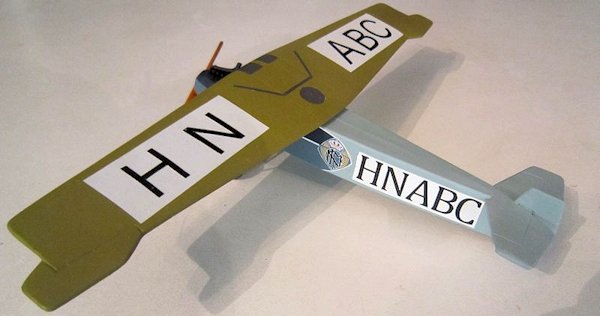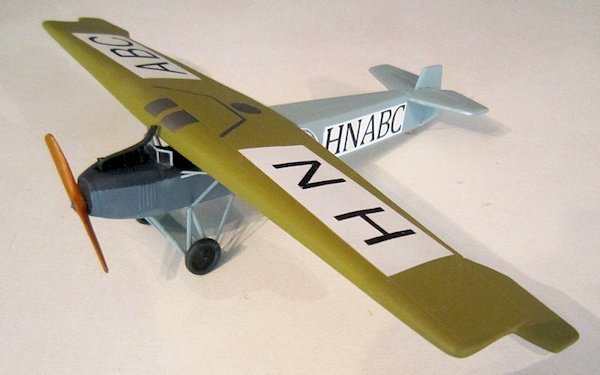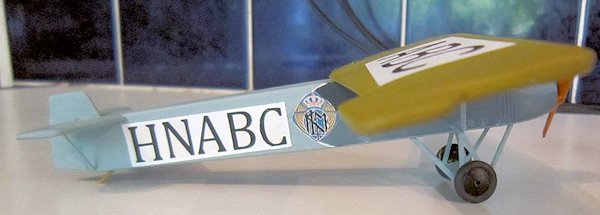
Classic Planes 1/72 Fokker F.II
| KIT #: | ? |
| PRICE: | $10 second hand |
| DECALS: | None |
| REVIEWER: | Chris Peachment |
| NOTES: | Basic vacuform kit |

| HISTORY |
In an
age of biplanes, The Fokker FII was a high wing monoplane which began Fokker's
use of the very thick aerofoil section, which although it had high a very high
drag factor, also had a high lift factor, and allowed internal bracing within
the wing, which in turn allowed for little external bracing. The fuselage was of
plain square section, and made of aluminium tubing covered in fabric.
Interestingly, there is no fin, as
 the
narrowed fuselage at the rear gave sufficient directional stability. There is
room inside for four seats, and there was the possibility of a fifth passenger
sitting in a seat next to the pilot, originally intended for a mechanic. Early
airline passengers electing this seat would have been intrepid, as the cockpit
was open, and the engine immediately alongside their left leg. The aircraft was
operated by Lufthansa in a colour scheme which is much simpler than the one I
chose, which is for a KLM machine who used the machine until from 1920 to 1927
before selling them on to Sabena. The Lufthansa machines were in use until 1934.
the
narrowed fuselage at the rear gave sufficient directional stability. There is
room inside for four seats, and there was the possibility of a fifth passenger
sitting in a seat next to the pilot, originally intended for a mechanic. Early
airline passengers electing this seat would have been intrepid, as the cockpit
was open, and the engine immediately alongside their left leg. The aircraft was
operated by Lufthansa in a colour scheme which is much simpler than the one I
chose, which is for a KLM machine who used the machine until from 1920 to 1927
before selling them on to Sabena. The Lufthansa machines were in use until 1934.
| THE KIT |
I found this in the second hand box of a dealer at an IPMS model meeting at in North London. The kit dates from some time in 1980s at a guess, and while straightforward, presents the usual problems of constructing a vacform. I think that originally it came with decals, which would have been a great help, but these were missing. The plastic is white and medium soft, which helps with the carving and sanding.
| CONSTRUCTION |
I
began with the usual careful cutting around the edges of the vacformed parts and
separation from the carrier sheet, and then many hours of carving and sanding
down. The moulding is good for a
vacform and has no compound curves to make life any harder. Leading and trailing
edges must be sanded down to a thin edge. Once sanding is complete, I went over
the whole thing using one of my wife's nail polishing
sticks to get rid
of the scratches and restore a smooth surface.
 There is
no interior and having no information as to the layout of the few seats, I
painted the inside walls a dark blue and left it at that. Very little can be
seen through the windows, but if you are planning to have the door open, some
seating would be necessary. There
seats for four passengers, which I would guess would be in two rows of two. The
pilot's cockpit needs boxing in. I added a small seat, offset to the port side,
but that can't be seen either thanks to the overhang of the wing. The cockpit
was matt black, as is the whole upper nose area. I used small location tabs made
from the scrapped carrier sheet and glued inside to locate the edges of the two
fuselage halves.
There is
no interior and having no information as to the layout of the few seats, I
painted the inside walls a dark blue and left it at that. Very little can be
seen through the windows, but if you are planning to have the door open, some
seating would be necessary. There
seats for four passengers, which I would guess would be in two rows of two. The
pilot's cockpit needs boxing in. I added a small seat, offset to the port side,
but that can't be seen either thanks to the overhang of the wing. The cockpit
was matt black, as is the whole upper nose area. I used small location tabs made
from the scrapped carrier sheet and glued inside to locate the edges of the two
fuselage halves.
The wing is very think, but presented no fit problems. The leading edge was a little irregular in its join, but a few smears of filler soon put that right. Wing and fuselage must be kept separate, because of the complex colour scheme on the fuselage which needs a lot of masking.
| COLORS & MARKINGS |
The
wing was painted overall in Vallejo Dark Yellow, which is usually used for
Afrika Corps tanks. I can't quite make out what the wing on the original is made
of, but it looks like painted plywood, possibly with fabric covered ailerons.
The upper wing details which look like a fuel filler and a small walkway, were
masked off and done in gunmetal.
 The
fuselage was then masked off successively for the different colours, using
Lifecolor US Non Specular Blue Grey FS35189 for the rear section and French Blue
Grey FS 35237 for the forward lower fuselage and Matt Royal Blue FS 35050 for
the upper forward fuselage. The upper engine cowl ahead of the pilot is matt
black.
The
fuselage was then masked off successively for the different colours, using
Lifecolor US Non Specular Blue Grey FS35189 for the rear section and French Blue
Grey FS 35237 for the forward lower fuselage and Matt Royal Blue FS 35050 for
the upper forward fuselage. The upper engine cowl ahead of the pilot is matt
black.
This
was my first effort at making my own decals, and the results were not perfect
but encouraging enough to try again on future models. Fortunately, there is a
full colour side view of the aircraft on one of the sites listed below, and that
proved perfect for the KLM insignia, which would have been impossible to hand
paint. Once I had settled the size to the right scale, it was simply a matter of
putting a sheet of blank decal paper into the photocopier and pressing the copy
button. The results were pleasing, but of course the printer didn't print white,
and so a base of white decal paper had to be cut to the right size to fit
beneath.
So too
with the registration numbers on either side of the fuselage and upper wing.
White decal was simply cut to the right oblong shape, according to the scale
plans. And  then
a font of the right kind and size was selected from my computer and printed in
black onto more decal paper.
then
a font of the right kind and size was selected from my computer and printed in
black onto more decal paper.
Unfortunately the decal paper, which I bought from a local art store, was
thicker than the decals in high quality aircraft kits we are used to these days.
I suspect it is used for decorating drinking mugs and the like. What this means
is that the decals stand a little
proud from the surface of the aircraft. It can't be seen by the camera and
hardly by the naked eye, but if you run a fingernail over them, then there is a
very slight bump. And so the answer to that is: don't run a fingernail over
them.
| FINAL CONSTRUCTION |
I
fitted the tailplane next as that was easy to align. Two struts on either side
were made from plastic rod.
The
wing can now be mounted on the fuselage, with care taken to get the right amount
of overhang at the front. Photos would indicate that the leading edge aligns
with the front edge of the cockpit. Struts are provided in the vacform sheet,
but the they are one sided and so best made from plastic rod material of an
aerofoil shape. Measuring and cutting can be done with reference to the scale
drawings. The axle was
 made from
plastic card, sanded to an aerofoil shape, and small mounting axles from rod
were fixed at either end for the wheels.
made from
plastic card, sanded to an aerofoil shape, and small mounting axles from rod
were fixed at either end for the wheels.
Wheels
came from the spares box, and were painted dark grey for the tires and gloss
black for the hubs. The cylinder head of an inline engine was cut off a German
WWI engine from the spares box, and fitting into an oblong hole cut in the nose
of the fuselage. And the exhaust was also spares box, I suspect from a German
WWI aircraft. Fabricating one would be tricky.
A
section of clear plastic sheet was cut to size for the windscreen, the frames
masked and painted blue, and the end side-screens then bent into shape, at
slightly less than 45 degrees to the front screen. This can be cemented in place
using Clearfix. And Clearfix was also used for the side windows, formed by
circling a toothpick round and round inside the hole until the Clearfix filled
it all up.
The tailskid was trimmed from a length of plastic rod, painted wood brown and fitted on the under side towards the fin.
| CONCLUSIONS |
Quite
a large airliner in 1/72 from the Golden Age which is sadly not much covered by
mainstream kits. The Fokker lineage is clearly visible in the very thick wing
and the overhang of the leading edge above the open cockpit, features which
continued with the Fokker F VII and the tri-motor versions of it.
I would recommend it to someone who had a little experience with a vacform, and rather more than I have with making your own decals. The complex fuselage colour scheme needs planning. But it is pleasing to the eye, and makes a nice companion to the old Ford Tri-motor if you have one. Or the old Frog kit of the Southern Cross. Or indeed any airliner from the 20s or 30s that you can find.
| REFERENCES |
http://en.wikipedia.org/wiki/Fokker_F.II
http://www.dutch-aviation.nl/index5/Civil/index5-2%20F2.html
flugzeuginfo.net
airliners.net
http://www.flightglobal.com/pdfarchive/view/1920/1920%20-%201062.html
http://www.aviastar.org/air/holland/fokker_f-2.php
http://www.flickr.com/photos/sdasmarchives/7585235894/in/photostream/
Thanks to for the preview kit. You can find this kit at your favorite hobby shop or on-line retailer.
If you would like your product reviewed fairly and fairly quickly, please contact the editor or see other details in the Note to Contributors.